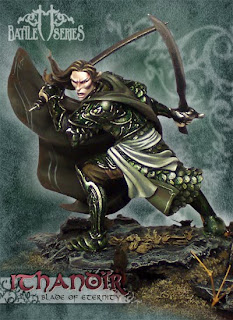Part 1: Your Sports All Suck is
here.
Before we start loving football, we have to know it. This will be a review for many of you, but there will be funny pictures later proving that football is totally not gay, so read on for that if nothing else.
Football is complicated, but this is what makes it fun to watch. So pay attention.
Football is played on a field like this:

Although regulation fields tend to be both larger and more grassy. The field is laid out with two
endzones, one on either end, with a 100-yard-long field in between. As you can see, the field is marked out in ten-yard increments. This will be important later.
A game of football is played in a series of setpiece plays called
downs, with specialized teams of eleven men on a side. One side plays
offense (they have the ball) while the other plays
defense. Whenever the ball
changes possession, they switch sides. There's also a thing called
special teams, but we'll get to that in a moment.
The winner of a football game is determined by who scores the most points. There are four ways to score points:
A
touchdown is when a player (on either offense, defense or special teams) is in
possession of the ball inside their opponent's endzone. This can be accomplished by running into the endzone with the ball, or catching the ball in the endzone.
 The signal for "touchdown". If the ref does this, you go "YAY!" or "FUCKING COWBOYS! GODAMNIT!!!", depending.
The signal for "touchdown". If the ref does this, you go "YAY!" or "FUCKING COWBOYS! GODAMNIT!!!", depending.A touchdown is worth
6 points.
A
field goal is when the offense kicks the ball between the
uprights of the
goal post (the big yellow letter Y) situated at the end of each endzone. It is significantly easier to score a field goal than a touchdown.
 Usually.
Usually.A field goal is worth
3 points.
A
safety occurs when a player on the offense in possession of the ball is tackled in his own endzone. Safeties are very rare, and it means the defense is doing a hell of a job.
 Also that your offense is screwed. *cough* not gay *cough*.
Also that your offense is screwed. *cough* not gay *cough*.
A safety is worth
2 points.
Finally, after every touchdown, the offense has the choice of going for an
extra point or a
two-point conversion.
An extra point is a super-easy short field goal. They are only worth
1 point, but are pretty much a gimme.
A two-point conversion is an "easy" short touchdown attempt. They are much harder than extra points. Worth
2 points. Hence the name.
Pro teams almost never "go for 2" unless there is a mathematical reason they either NEED 2 points or have nothing to gain by only getting 1. Or they want to really embarrass the other team. Neither of which happens very often.
Hence, touchdowns are really worth
7 points.
So a field goal is worth just less than half of a touchdown, practically speaking. This is why you will hear announcers talk about teams "settling for a field goal" instead of "going for the touchdown".
Now, as I mentioned earlier, football is played in a series of setpiece plays, or downs. Each down is a chance to move the ball closer to your opponent's endzone from the
line of scrimmage, which is an imaginary line across the field where the ball starts each play, which divides the offense from the defense until the play starts.
The offense starts with four downs. Each time they move the ball ten yards forward from the original line of scrimmage, they get another four downs. This is called a
first down. You can tell when a player does this because of the cool imaginary yellow line the TV people draw for us.
 Fun Fact: It's considered perfectly normal to tease the noobs by telling them they have a team of specially trained technicians erase the old line and paint a new one every play. Welcome to the club.
Fun Fact: It's considered perfectly normal to tease the noobs by telling them they have a team of specially trained technicians erase the old line and paint a new one every play. Welcome to the club.
Each down is called by it's number, and the number of yards the ball has to go to get a first down.
1st and 10 is what starts every new set of downs.
2nd and 5 is what you get after a good running play on 1st down.
3rd and 20 means your quarterback is about to get killed.
 Kinda like this. He's under there somewhere. NB: This is TOTALLY NOT GAY.
Kinda like this. He's under there somewhere. NB: This is TOTALLY NOT GAY.
Note that while the offense has four downs to get the ball ten yards, they really only have three (usually). This is because, if they fail to convert on fourth down, the other team gets the ball wherever it was. This is where special teams come in.
The offense has the option of kicking a field goal or punting the ball on any down, although they normally only do either on 4th down. Kicking a field goal gets you 3 points. Punting (which involves drop-kicking the ball instead of place-kicking it, as a field goal does) lets you (hopefully) kick the ball way the hell into your opponent's territory, so their offense will have a much harder time.On both punts and
kickoffs -- a place-kick where one team gives the ball away to the other, both at the start of each half and after each score -- the
receiving team has a chance to
return the ball. That is to say, one guy catches the ball and runs like hell, while everyone else on the other team tries to take his head off. They are not called "special teams" because what they do is special or rare. They are called "special" because they are frickin' suicidal, on both sides of the ball.
The Wag hopes this has been edifying, and that the accompanying images have proven beyond a reasonable doubt that football is not gay.
 See? TOTALLY not gay. Except in the lesbian way. If football players were hot lipstick lesbians in pads instead of three-hundred pound hunks of glorious, thundering man-meat.
See? TOTALLY not gay. Except in the lesbian way. If football players were hot lipstick lesbians in pads instead of three-hundred pound hunks of glorious, thundering man-meat.
Okay, it may be kinda gay.Next time: Can't Tell Your Players Without a Program, or Why They Always Make Fun of Punters.
-- The Prolix Wag
The trademark is pending on "hunk of glorious, thundering man-meat", so don't even think about it.



 For example, the player on the far left is a Wide Receiver. The player next to him is a Linebacker. The player on the right is a Quarterback. The player in the middle is a total lardass.
For example, the player on the far left is a Wide Receiver. The player next to him is a Linebacker. The player on the right is a Quarterback. The player in the middle is a total lardass.
 The quarterback is the offense's leader on the field, the one who communicates the plays from the coach to the rest of the team and calls out the snap count that tells the Center when to hike the ball. They have to be smart, poised, and able to throw the ball really far and really accurately. Being able to run around some (being a "mobile quarterback") is useful, but not strictly necessary. QBs are tall, handsome, usually somewhat bland pretty boys who tend to scream "Not in the face!" a lot. They are also better paid than everyone else on the team, and the offense is crippled without a good one. In D&D terms, they are Human Warlords.
The quarterback is the offense's leader on the field, the one who communicates the plays from the coach to the rest of the team and calls out the snap count that tells the Center when to hike the ball. They have to be smart, poised, and able to throw the ball really far and really accurately. Being able to run around some (being a "mobile quarterback") is useful, but not strictly necessary. QBs are tall, handsome, usually somewhat bland pretty boys who tend to scream "Not in the face!" a lot. They are also better paid than everyone else on the team, and the offense is crippled without a good one. In D&D terms, they are Human Warlords.


 The tight end is a mix between a receiver and a blocker, although the second and third tight ends are usually just blockers they bring in on running plays who may catch a pass, but only if God demands it outright, in tripilicate. They are big, but fast and athletic, and have good hands. In D&D terms, they are multiclassed Goliath Fighter/Barbarians.
The tight end is a mix between a receiver and a blocker, although the second and third tight ends are usually just blockers they bring in on running plays who may catch a pass, but only if God demands it outright, in tripilicate. They are big, but fast and athletic, and have good hands. In D&D terms, they are multiclassed Goliath Fighter/Barbarians.

 The signal for "touchdown". If the ref does this, you go "YAY!" or "FUCKING COWBOYS! GODAMNIT!!!", depending.
The signal for "touchdown". If the ref does this, you go "YAY!" or "FUCKING COWBOYS! GODAMNIT!!!", depending. Fun Fact: It's considered perfectly normal to tease the noobs by telling them they have a team of specially trained technicians erase the old line and paint a new one every play. Welcome to the club.
Fun Fact: It's considered perfectly normal to tease the noobs by telling them they have a team of specially trained technicians erase the old line and paint a new one every play. Welcome to the club. Kinda like this. He's under there somewhere. NB: This is TOTALLY NOT GAY.
Kinda like this. He's under there somewhere. NB: This is TOTALLY NOT GAY. See? TOTALLY not gay. Except in the lesbian way. If football players were hot lipstick lesbians in pads instead of three-hundred pound hunks of glorious, thundering man-meat.
See? TOTALLY not gay. Except in the lesbian way. If football players were hot lipstick lesbians in pads instead of three-hundred pound hunks of glorious, thundering man-meat. Never got over the thrill of being on Math Team? Lack the imagination for D&D? Then by god, have I got a sport for you.
Never got over the thrill of being on Math Team? Lack the imagination for D&D? Then by god, have I got a sport for you. Some day, some fine and wonderful day, she will be mine, and Steve Jackson shall ride shotgun.
Some day, some fine and wonderful day, she will be mine, and Steve Jackson shall ride shotgun.






